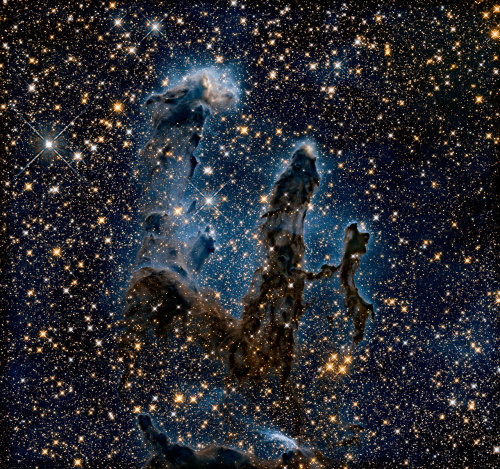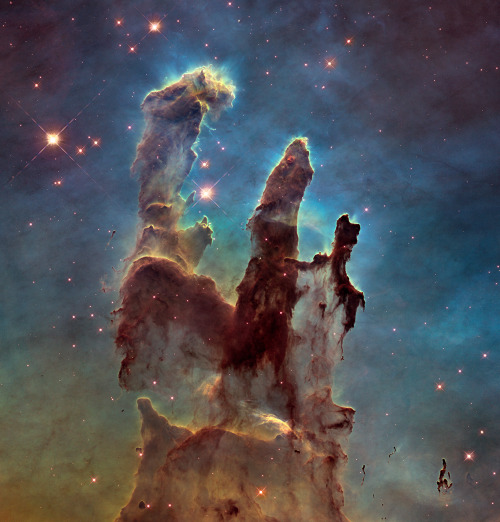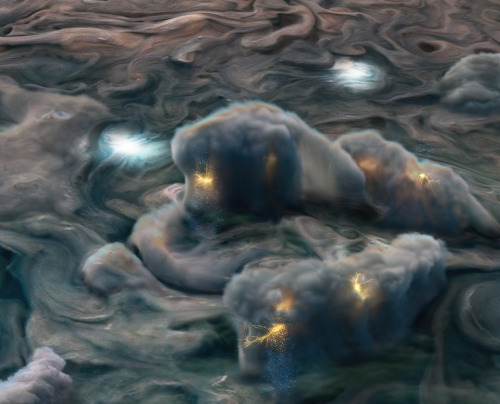Six Things You Need To Know About The Green Propellant Infusion Mission
Six Things You Need to Know About the Green Propellant Infusion Mission
Next week, we’re launching a new “green” fuel to space for the first time! The Green Propellant Infusion Mission (GPIM)—which consists of a non-toxic liquid, compatible propulsion system and the small satellite it’s riding on—will demonstrate how our technology works so that future missions can take advantage of this safer, more efficient fuel alternative.

Here are six key facts to know about our Green Propellant Infusion Mission:
1) The Air Force Research Lab developed the “green” fuel.
The AFRL’s hydroxyl ammonium nitrate fuel/oxidizer blend—called AF-M315E—is actually peach in color. This liquid doesn’t require the kind of strict, handling protocols that conventional chemicals currently require. Think shirtsleeves instead of hazmat suits, which could reduce pre-launch ground processing time for a spacecraft from weeks to days!

Image Credit: Air Force Research Lab
2) It’s safer and more efficient.
The non-toxic fuel offers nearly 50% better performance when compared to today’s highly toxic chemical propellant, hydrazine. That’s equivalent to getting 50% more miles per gallon on your car. This means spacecraft can travel farther or operate for longer with less propellant in their fuel tanks.

3) The fuel can handle extreme temperatures.
Even on missions to extremely cold environments, such as the south pole of Mars – where temperatures can dip as low as -225 degrees Fahrenheit and carbon-dioxide ice “spiders” can form (see below) – AF-M315E won’t freeze, but rather just transforms into a glass transition phase. This means even though it turns into a solid, it won’t cause spacecraft components to stretch or expand, so the spacecraft only has to warm up the fuel when it needs it.

4) Industry is already lining up to use the technology.
Our commercial partners report that there is a lot of interest and potential for this tech. After we successfully prove how it works in space, small satellites to large spacecraft could benefit by using the green propellant system. It’d only be a matter of time before companies begin building the new systems for market.

5) GPIM required a team of talented engineers.
Engineers at Aerojet Rocketdyne in Redmond, Washington developed new, optimized hardware like thrusters, tanks, filters and valves to work with the green fuel. GPIM uses a set of thrusters that fire in different scenarios to test engine performance and reliability.

Ball Aerospace of Boulder, Colorado designed and built the mini fridge-sized spacecraft bus and pieced it all together.

Before being ready for flight, GPIM components went through rigorous testing at multiple NASA centers including our Glenn Research Center, Goddard Space Flight Center and Kennedy Space Center. The program team at Marshall Space Flight Center manages the mission. Once in orbit, researchers will work together to study how the fuel is performing as they manipulate the spacecraft. The demonstration mission will last about 13 months.
6) GPIM will hitch a ride on a SpaceX Falcon Heavy rocket.
SpaceX’s Falcon Heavy rocket will launch for a third time for the U.S. Department of Defense’s Space Test Program-2 (STP-2) mission targeted for June 24, 2019 at 11:30 p.m. EDT. With nearly two dozen other satellites from government, military and research institutions, GPIM will deploy within a few hours after launch from NASA’s Kennedy Space Center in Florida. The SpaceX Falcon Heavy launch will be live-streamed here: https://www.nasa.gov/live

Follow @NASA_Technology on Twitter for news about GPIM’s launch.
Make sure to follow us on Tumblr for your regular dose of space: http://nasa.tumblr.com.
More Posts from Nasa and Others
Hello, Scott? It’s President Obama.
This afternoon, President Obama spoke by phone with astronaut Scott Kelly to welcome him back to Earth from his record-breaking yearlong mission on the International Space Station.

President Obama, above, is seen talking on the phone with Scott Kelly in the Oval Office on March 2, 2016. (Official White House Photo by Pete Souza)
The President thanked Kelly for his service, for sharing his journey with people across the globe through social media, for his participation in important research about what it will take for us to make long journeys in space, and for inspiring a new generation of young people to pursue studies and careers in science, technology, engineering, and mathematics.

The President also noted that Kelly’s year in space would provide critical data to researchers trying to understand how to keep astronauts healthy during long space voyages and fulfill the President’s vision of putting American astronauts on Mars in the 2030s.
Thanks to Kelly’s work, in addition to that of everyone at NASA and in the U.S. space industry, the President believes the United States will be successful in that journey to Mars and will continue to lead and inspire the world in space exploration.
Make sure to follow us on Tumblr for your regular dose of space: http://nasa.tumblr.com
Happy Halloween From The Space Place!
In a dark conference room, a pumpkin gently landed on the Moon, its retrorockets smoldering, while across the room, a flying saucer pumpkin hovered above Area 51 as a pumpkin alien wreaked havoc.

Suffice to say that when the scientists and engineers at our Jet Propulsion Laboratory in Pasadena, California, compete in a pumpkin-carving contest, the solar system's the limit. Now in its ninth year, the contest gives teams only one hour to carve (off the clock, on their lunch break), though they can prepare non-pumpkin materials — like backgrounds, sound effects and motorized parts — ahead of time.
Enjoy!













Looking for more pumpkin fun? Check out the full gallery, here.
Make sure to follow us on Tumblr for your regular dose of space: http://nasa.tumblr.com
Crazy Facts About the #YearInSpace
Astronaut Scott Kelly and Russian cosmonaut Mikhail Kornienko returned from their One-Year Mission on March 1. When you spend a year doing anything, you’re bound to accumulate some crazy stats. Here are a few:

During their year in space, Kelly and Kornienko traveled over 143 million miles, conducting research to prepare us for our journey to Mars, which will be about 140,000,000 miles from Earth.

The International Space Station travels at a speed of 5 miles per second and orbits the Earth every 90 minutes.

These visiting vehicles brought food, supplies, experiments and more crew members to the space station.

Since the space station is orbiting the Earth at 17,500 miles per hour, the crew onboard sees 16 sunrises and sunsets each day.

Water is a precious and limited resource in space, so crew members recycle it whenever possible. That includes recycling their own urine.
Make sure to follow us on Tumblr for your regular dose of space: http://nasa.tumblr.com

Chris Williams
Born in New York City, Chris Williams considers Potomac, Maryland, to be his hometown. A private pilot and Eagle Scout, Williams is a board-certified medical physicist and holds a doctorate in physics from MIT. https://go.nasa.gov/49YJJmf
Make sure to follow us on Tumblr for your regular dose of space!
Why do scientists think there could have been life on Mars?

Hello there 👋
Welcome back to Mindful Mondays! 🧘
Mondays are, famously, most people’s seventh favorite day of the week. And Mondays where everything is darker, longer, and colder than normal? Thanks, but no thanks.
But don’t panic; we’ve got something to help. It might be small, but it can make a big difference. Just ten minutes of mindfulness can go a long way, and taking some time out to sit down, slow down, and breathe can help center your thoughts and balance your mood. Sometimes, the best things in life really are free.
This year, we have teamed up with the good folks at @nasa. They want you to tune in and space out to relaxing music and ultra-high-definition visuals of the cosmos—from the surface of Mars.
Sounds good, right? Well, it gets better. Watch more Space Out episodes on NASA+, a new no-cost, ad-free streaming service.
Why not give it a try? Just a few minutes this Monday morning can make all the difference, and we are bringing mindfulness straight to you.
🧘WATCH: Space Out with NASA: Martian Landscapes, 11/27 at 1pm EST🧘



Sometimes... there’s more than meets the eye. 👀 You’re looking at two very different takes on an iconic image.
Human eyes can see only a small portion of the range of radiation given off by the objects around us. We call this wide array of radiation the electromagnetic spectrum, and the part we can see visible light.
In the first image, researchers revisited one of Hubble Space Telescope’s most popular sights: the Eagle Nebula’s Pillars of Creation. Here, the pillars are seen in infrared light, which pierces through obscuring dust and gas and unveil a more unfamiliar — but just as amazing — view of the pillars. The entire frame is peppered with bright stars and baby stars are revealed being formed within the pillars themselves. The image on the bottom is the pillars in visible light.
Image Credit: NASA, ESA/Hubble and the Hubble Heritage Team
Make sure to follow us on Tumblr for your regular dose of space: http://nasa.tumblr.com.

Spotted: signs of a planet about 28 million light-years away 🔎 🪐
For the first time, astronomers may have detected an exoplanet candidate outside of the Milky Way galaxy. Exoplanets are defined as planets outside of our Solar System. All other known exoplanets and exoplanet candidates have been found in the Milky Way, almost all of them less than about 3,000 light-years from Earth.
This new result is based on transits, events in which the passage of a planet in front of a star blocks some of the star's light and produces a characteristic dip. Researchers used our Chandra X-ray Observatory to search for dips in the brightness of X-rays received from X-ray bright binaries in the spiral galaxy Messier 51, also called the Whirlpool Galaxy (pictured here). These luminous systems typically contain a neutron star or black hole pulling in gas from a closely orbiting companion star. They estimate the exoplanet candidate would be roughly the size of Saturn, and orbit the neutron star or black hole at about twice the distance of Saturn from the Sun.
This composite image of the Whirlpool Galaxy was made with X-ray data from Chandra and optical light from our Hubble Space Telescope.
Credit: X-ray: NASA/CXC/SAO/R. DiStefano, et al.; Optical: NASA/ESA/STScI/Grendler
Make sure to follow us on Tumblr for your regular dose of space!

New results from our Juno mission suggest the planet is home to “shallow lightning.” An unexpected form of electrical discharge, shallow lightning comes from a unique ammonia-water solution.
It was previously thought that lightning on Jupiter was similar to Earth, forming only in thunderstorms where water exists in all its phases – ice, liquid, and gas. But flashes observed at altitudes too cold for pure liquid water to exist told a different story. This illustration uses data obtained by the mission to show what these high-altitude electrical storms look like.
Understanding the inner workings of Jupiter allows us to develop theories about atmospheres on other planets and exoplanets!
Illustration Credit: NASA/JPL-Caltech/SwRI/MSSS/Gerald Eichstädt/Heidi N. Becker/Koji Kuramura
Make sure to follow us on Tumblr for your regular dose of space: http://nasa.tumblr.com
OMG! Ice is Melting from Below

Oceans Melting Greenland (OMG) scientists are heading into the field this week to better understand how seawater is melting Greenland’s ice from below. (Yes, those black specks are people next to an iceberg.) While NASA is studying ocean properties (things like temperature, salinity and currents), other researchers are eager to incorporate our data into their work. In fact, University of Washington scientists are using OMG data to study narwhals – smallish whales with long tusks – otherwise known as the “unicorns of the sea.”
Our researchers are also in the field right now studying how Alaska’s ice is changing. Operation IceBridge, our longest airborne campaign, is using science instruments on airplanes to study and measure the ice below.
What happens in the Arctic doesn’t stay in the Arctic (or the Antarctic, really). In a warming world, the greatest changes are seen in the coldest places. Earth’s cryosphere – its ice sheets, sea ice, glaciers, permafrost and snow cover – acts as our planet’s thermostat and deep freeze, regulating temperatures and storing most of our freshwater. Next month, we’re launching ICESat-2, our latest satellite to study Earth’s ice!
Make sure to follow us on Tumblr for your regular dose of space: http://nasa.tumblr.com.
-
 madebymaryssa liked this · 1 month ago
madebymaryssa liked this · 1 month ago -
 stupendoustaleheart liked this · 3 years ago
stupendoustaleheart liked this · 3 years ago -
 tacocat-awkwardness liked this · 4 years ago
tacocat-awkwardness liked this · 4 years ago -
 explosivetelepathy liked this · 4 years ago
explosivetelepathy liked this · 4 years ago -
 pokeycub liked this · 4 years ago
pokeycub liked this · 4 years ago -
 allthelove-em liked this · 4 years ago
allthelove-em liked this · 4 years ago -
 im-gonna-be-late liked this · 4 years ago
im-gonna-be-late liked this · 4 years ago -
 innerfa18eww2tarawadean liked this · 5 years ago
innerfa18eww2tarawadean liked this · 5 years ago -
 miniaturelandmakerranch-blog liked this · 5 years ago
miniaturelandmakerranch-blog liked this · 5 years ago -
 cookie0419 reblogged this · 5 years ago
cookie0419 reblogged this · 5 years ago -
 skyfvllofstxrs reblogged this · 5 years ago
skyfvllofstxrs reblogged this · 5 years ago -
 techsocialnetwork reblogged this · 5 years ago
techsocialnetwork reblogged this · 5 years ago -
 techsocialnetwork liked this · 5 years ago
techsocialnetwork liked this · 5 years ago -
 yarn-ace liked this · 5 years ago
yarn-ace liked this · 5 years ago -
 redjustine liked this · 5 years ago
redjustine liked this · 5 years ago -
 shadesyste liked this · 5 years ago
shadesyste liked this · 5 years ago -
 ferociousqueak liked this · 5 years ago
ferociousqueak liked this · 5 years ago -
 fourthage reblogged this · 5 years ago
fourthage reblogged this · 5 years ago -
 multifandomtrashpanda liked this · 5 years ago
multifandomtrashpanda liked this · 5 years ago -
 nyxxielove liked this · 5 years ago
nyxxielove liked this · 5 years ago -
 ssddsnake55 liked this · 5 years ago
ssddsnake55 liked this · 5 years ago
Explore the universe and discover our home planet with the official NASA Tumblr account
1K posts